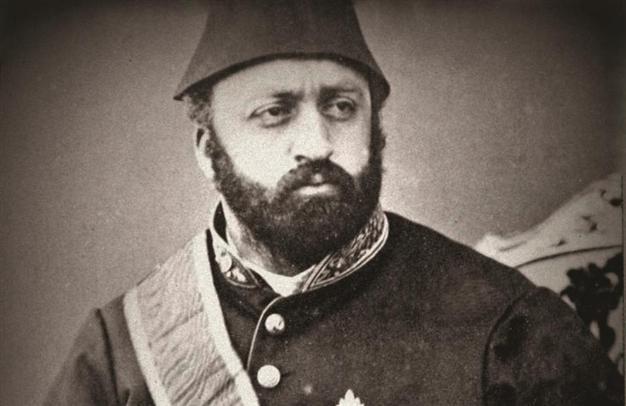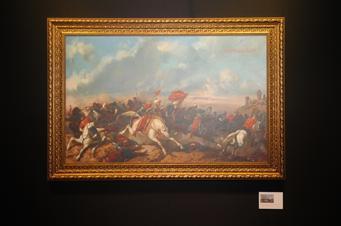A sultan who loved art: Abdülaziz and painting
ISTANBUL - Anadolu Agency

Some of the paintings by Sultan Abdülaziz at the exhibtion were taken from Poland National Museum of Art. AA photos
The International Culture and Arts Association (UKSD) presents a new exhibition: “Sultan Abdülaziz with paintings,” which has opened at Dolmabahçe Art Gallery. The opening hosted UKSD president Tuğrul Tuna and Küçükçekmece mayor Aziz Yeniay.
The exhibition consists of 12 unsigned portraits and paintings by Sultan Abdülaziz that belong to the National Palaces Painting collection. The collection had given permission six months earlier and the paintings were bought from Poland’s Krakow National Museum. There are also etchings and sketches by Abdülaziz.
Even though the paintings are unsigned the experts have worked on them and discovered that the sketches matched up with each other. The sketches and also the paintings were produced by Abdülaziz who was also a painter.
Abdülaziz was also known for his love of art and his interest in art. Speaking at the opening of the exhibition, UKSD President Tuna, said they were very happy to organize such an exhibition.
Tuna said the paintings had been bought 6 months before and they were found to match with the other paintings of Abdülaziz in the National Palace Collection.
An exclusive museum for National Collections opened in Istanbul’s Dolmabahçe Museum last year. The museum is home to 43,000 artifacts dating back to the 19th century and exhibits the daily life in the empire’s palaces.

Curator of the ‘Sultan Abdülaziz with paintings,’
exhibtion Mehmet Lütfi Şen (above) says Ottoman
sultans always dealt with art and painting.
Tuna added that there was much research taking place concerning these paintings. Even though they were not signed they were determined to belong to Abdülaziz.
Noting that this was a first in the history of Turkish painting, Tuna said, there were many paintings that were thought to belong to Chlebowski, however they were subsequently found not to. In the years 1864-1876 Chlebowski was master painter for Sultan Abdülaziz and took up residence in Constantinople. It is known that Chlebowski became popular with the Sultanate. During his services, he had obtained permission to bring with him a large Icon of Mother of God Leading our Way, which had been rescued from an Odegon Monastery in 1453. He had come across it in one of the magazines with old relics, unheeded by the Ottoman keeper. This account is certified in a letter by the Comité National Polonais a Constantinople, dated June 27, 1938.
In 1876 he moved to Paris. In 1881 he returned permanently to Krakow. The subject matter of his watercolors and oil paintings is diverse. He painted images of historical battles related to the history of Turkey, oriental genre scenes, landscapes, and portraits of Sultans.
The curator of the exhibition Mehmet Lütfi Şen said Ottoman sultans always dealt with art and painting. “Today we discover a painter after 137 years.”
It is known that Abdülaziz took painting lessons when he was young, said Şen.
“In the past Abdülaziz never signed his own paintings and this is known for sure and we know that he had given his paintings to Polish painter Stanislav Chlebowski, while he was leaving Istanbul,” said Şen, adding that Chlebowski had kept them.
Later on these paintings were unearthed at National Museum of Poland, he added. “The museum has bought these paintings from the painter’s family and added them to their collection and we have traced them and obtained the permissions to display them.”
After we saw the sketches we discovered that these paintings were part of the Abdülaziz paintings because they matched with the national museum collections of Turkey, added Şen, noting that experts also worked on them and discovered that these paintings belonged to Abdülaziz.
Ömer Faruk Şerifoğlu, an art history expert said the oil on canvas paintings belonged to Abdülaziz.
 About National Collections
About National CollectionsThere are 70,000 artifacts in the inventory of the national palaces and among the objects to be displayed in the museum are kitchen tools, dinner sets, textile materials, manuscripts, lightning and heating tools and historical carpets.
Nearly 15,000 artifacts in the inventory can be seen in the museums. The rest is protected in a very modern depot, which has been produced with the latest technology. Researchers, experts and history buffs can see these artifacts.
It is possible to learn about the life of sultans from a book, but those who are curious about their shaving tools, their children’s dresses and their education, can see the answers with their own eyes at the national palaces collection for many experts.
Abdülaziz era and Ottoman Empire
Born at Istanbul’s Eyüp Palace in 1830, Abdülaziz received an Ottoman education but was nevertheless an ardent admirer of the material progress that was made in the West. The Sultan took an interest in documenting the Sultanate. He was also interested in literature and was also a classical music composer. Some of his compositions have been collected in the album “European Music at the Ottoman Court” by the London Academy of Ottoman Court Music. The biggest achievement of Abdülaziz was to modernize the Ottoman Navy. In 1875, the Navy had 21 battleships and 173 warships of other types, ranking as the third largest navy in the world after the British and French navies. He established the first Ottoman railroad network and Sirkeci Train Station in Constantinople, terminus of the Orient Express. Impressed by the museums in London, Paris and Vienna, he established the Istanbul Archaeology Museum. Under Abdülaziz’s reign, Turkey’s first postage stamps were issued in 1863, and The Ottoman Empire joined the Universal Postal Union in 1875 as a founding member. He was made the 756th Knight of the Order of the Garter in 1867 and the 127th Grand Cross of the Order of the Tower and Sword.


 About National Collections
About National Collections